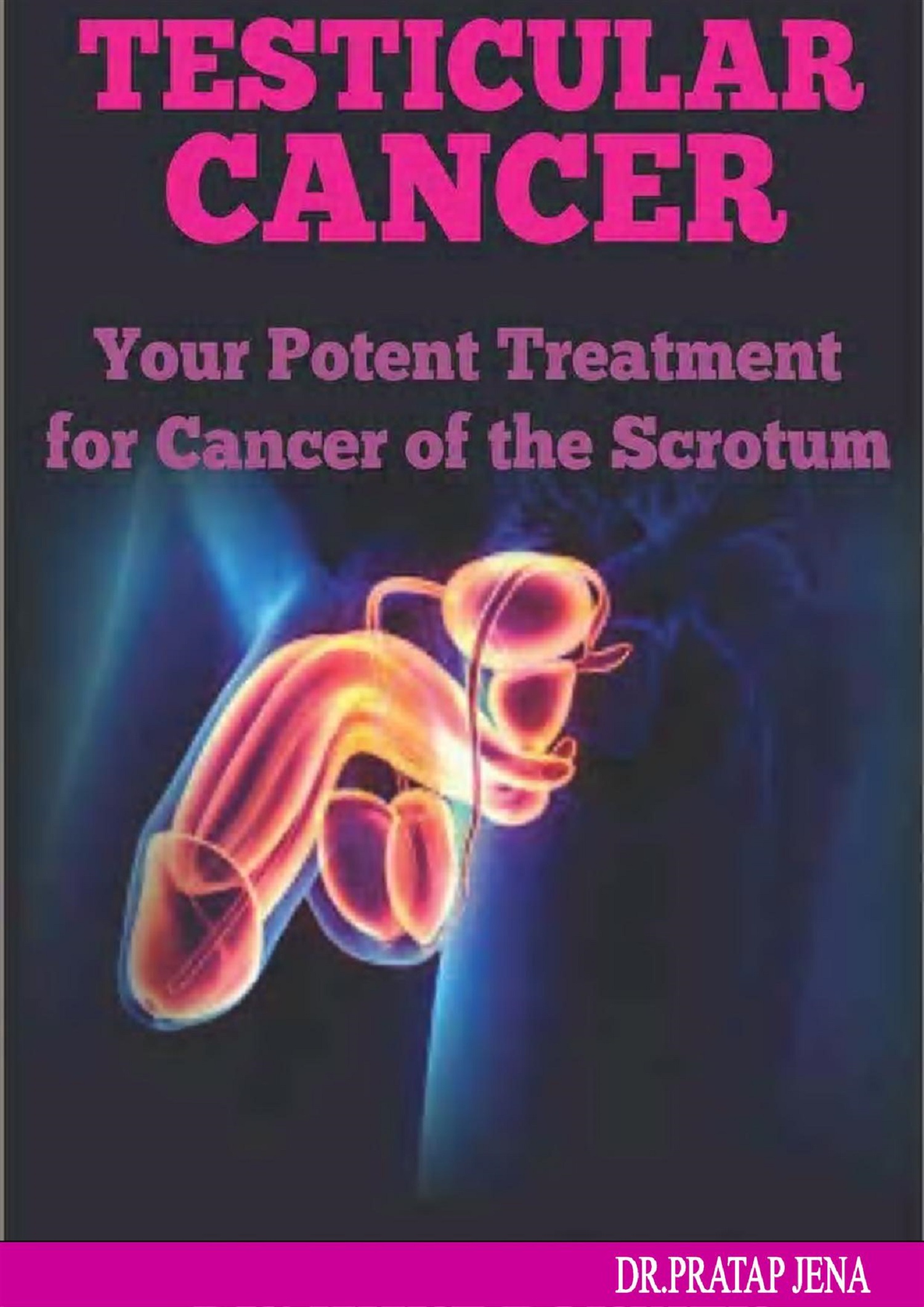
TESTICULAR CANCER
On Sale
$3.00
$3.00
Testicular cancer is an anomalous development of cells found in the balls or testicles. The balls are the male regenerative organs (gonads) where sperm are delivered.
•The two small testicular organs lie in a pocket of skin underneath and behind the penis called the scrotal sac, or scrotum.
•They are joined to the ejaculatory pipe in the lower pelvis by strings called spermatic ropes, which contain the vas deferens, the thin tube through which the sperm moves out of the testis.
•Beside delivering and putting away sperm, the gonads (or testicles) are the primary wellspring of male hormones, for example, testosterone, which are fundamental for typical sex drive (moxie), for erections, discharge, and which drive advancement of male physical characteristics, for example, profound voice and body and facial hair.
•Cancer more often than not happens in just a single gonad. Under 5% of the time, it happens in the two balls. (Normally, if a second testicular cancer emerges, the two tumors are found at various circumstances, the second maybe years after the fact.)
Male Illustration - Testicular Cancer
Cancer happens when typical cells change and start to develop and increase without ordinary controls.
•This uncontrolled development brings about a mass of irregular cells called a tumor.
•Some tumors develop rapidly, others all the more gradually.
•Tumors are on the grounds that they overpower encompassing sound tissue, taking its space as well as the oxygen and supplements it needs to complete its ordinary capacities.
Not all tumors are cancer. A tumor is considered cancer in the event that it is harmful. This implies, if the tumor isn't dealt with and ceased, it will spread to different parts of the body. Different tumors are named kind on the grounds that their cells don't spread to different organs. In any case, all tumors begin to cause indications when they get sufficiently extensive.
•Malignant tumors can spread to neighbouring structures, typically lymph hubs. They attack these solid tissues, hindering their capacity and in the long run decimate them.
•Tumor cells in some cases enter the circulation system and spread to removed organs. There, they can develop as comparative however isolate tumors. This procedure is called metastasis.
•The most normal spots for testicular cancer to spread are the lymph hubs in the territory close to the kidneys (situated in the back of the stomach region and alluded to as the retroperitoneum region), and are called the retroperitoneal lymph hubs. It likewise can spread to the lungs, liver, and once in a while to the mind.
•Metastatic cancers emerging in the testicles are harder to cure than kind hearted tumors, yet at the same time have high cure rates.
Testicular cancers can be included one or a few distinct sorts of tumor cells. The sorts depend on the cell write from which the tumor emerges.
•By far the most widely recognized compose is germ cell carcinoma. These tumors emerge from the sperm framing cells inside the testicles.
•Most of the data exhibited here concerns germ cell tumors.
There are two kinds of germ cells tumors, seminomas and non seminomas.
•Seminomas emerge from just a single kind of cell: juvenile germ cells that have not yet separated, or transformed into the particular sorts of tissues they will move toward becoming in the typical testis. These constitute around 40% of every testicular cancer.
•Non seminomtous germ cell tumors are made out of develop cells that have officially specific. Subsequently, these tumors frequently are "blended," that is, they are comprised of in excess of one tumor write. Ordinary parts incorporate choriocarcinoma, embryonal carcinoma, juvenile teratoma, and yolk sac tumors. These tumors have a tendency to be more quickly developing and to spread more forcefully than seminomas.
Testicular cancer is the most widely recognized sort of cancer in young fellows 15-35 years old, yet it can happen at any age.
•It is certainly not a typical cancer, representing just 1%-2% of cancers in men.
•The American Cancer Society assessed that 8,800 new instances of testicular cancer can be analyzed in the United States and around 380 men will kick the bucket of the sickness in 2016.
•Testicular cancer is most basic in whites and minimum normal in blacks and Asians.
Testicular cancer is a standout amongst the most reparable everything being equal.
•The cure rate is more prominent than 90% for generally organizes. In men whose cancer is analyzed in a beginning period, the cure rate is almost 100%. Indeed, even those with metastatic ailment have a cure rate of more prominent than 80%.
•These figures apply just to men who get proper treatment for their cancer. Incite finding and treatment are fundamental.
•Because of its high cure rate, testicular cancer is viewed as the model of fruitful treatment for cancer starting in a strong organ. In 1970, 90% of men with metastatic testicular cancer passed on of the illness. By 1990, that figure had relatively switched - about 90% of men with metastatic testicular cancer were cured. Testicular Cancer Causes
It isn't known precisely what causes testicular cancers. Certain variables, recorded here, seem to expand a man's danger of building up a testicular cancer. Numerous others have been proposed, however are either problematic or undermined.
Cryptorchidism: The balls shape in the stomach area of the creating baby. While the hatchling is still in the womb, the balls start their continuous plummet to the scrotum. Frequently, this plummet isn't finished during childbirth however happens amid the main year of life. Disappointment of the gonad to fittingly plunge into the scrotum is called undescended gonad, or cryptorchidism.
•It can happen on one or the two sides.
•If the gonads don't completely slip, the baby more often than not experiences medical procedure to bring the testicle(s) into the scrotum.
•The risk for testicular cancer is three to five times higher in guys conceived with cryptorchidism, even after medical procedure to bring the testicle(s) into the scrotum.
•Because of this expanded risk, men with this sort of condition ought to be considerably more thorough about performing general testicular self-exams.
•The two small testicular organs lie in a pocket of skin underneath and behind the penis called the scrotal sac, or scrotum.
•They are joined to the ejaculatory pipe in the lower pelvis by strings called spermatic ropes, which contain the vas deferens, the thin tube through which the sperm moves out of the testis.
•Beside delivering and putting away sperm, the gonads (or testicles) are the primary wellspring of male hormones, for example, testosterone, which are fundamental for typical sex drive (moxie), for erections, discharge, and which drive advancement of male physical characteristics, for example, profound voice and body and facial hair.
•Cancer more often than not happens in just a single gonad. Under 5% of the time, it happens in the two balls. (Normally, if a second testicular cancer emerges, the two tumors are found at various circumstances, the second maybe years after the fact.)
Male Illustration - Testicular Cancer
Cancer happens when typical cells change and start to develop and increase without ordinary controls.
•This uncontrolled development brings about a mass of irregular cells called a tumor.
•Some tumors develop rapidly, others all the more gradually.
•Tumors are on the grounds that they overpower encompassing sound tissue, taking its space as well as the oxygen and supplements it needs to complete its ordinary capacities.
Not all tumors are cancer. A tumor is considered cancer in the event that it is harmful. This implies, if the tumor isn't dealt with and ceased, it will spread to different parts of the body. Different tumors are named kind on the grounds that their cells don't spread to different organs. In any case, all tumors begin to cause indications when they get sufficiently extensive.
•Malignant tumors can spread to neighbouring structures, typically lymph hubs. They attack these solid tissues, hindering their capacity and in the long run decimate them.
•Tumor cells in some cases enter the circulation system and spread to removed organs. There, they can develop as comparative however isolate tumors. This procedure is called metastasis.
•The most normal spots for testicular cancer to spread are the lymph hubs in the territory close to the kidneys (situated in the back of the stomach region and alluded to as the retroperitoneum region), and are called the retroperitoneal lymph hubs. It likewise can spread to the lungs, liver, and once in a while to the mind.
•Metastatic cancers emerging in the testicles are harder to cure than kind hearted tumors, yet at the same time have high cure rates.
Testicular cancers can be included one or a few distinct sorts of tumor cells. The sorts depend on the cell write from which the tumor emerges.
•By far the most widely recognized compose is germ cell carcinoma. These tumors emerge from the sperm framing cells inside the testicles.
•Most of the data exhibited here concerns germ cell tumors.
There are two kinds of germ cells tumors, seminomas and non seminomas.
•Seminomas emerge from just a single kind of cell: juvenile germ cells that have not yet separated, or transformed into the particular sorts of tissues they will move toward becoming in the typical testis. These constitute around 40% of every testicular cancer.
•Non seminomtous germ cell tumors are made out of develop cells that have officially specific. Subsequently, these tumors frequently are "blended," that is, they are comprised of in excess of one tumor write. Ordinary parts incorporate choriocarcinoma, embryonal carcinoma, juvenile teratoma, and yolk sac tumors. These tumors have a tendency to be more quickly developing and to spread more forcefully than seminomas.
Testicular cancer is the most widely recognized sort of cancer in young fellows 15-35 years old, yet it can happen at any age.
•It is certainly not a typical cancer, representing just 1%-2% of cancers in men.
•The American Cancer Society assessed that 8,800 new instances of testicular cancer can be analyzed in the United States and around 380 men will kick the bucket of the sickness in 2016.
•Testicular cancer is most basic in whites and minimum normal in blacks and Asians.
Testicular cancer is a standout amongst the most reparable everything being equal.
•The cure rate is more prominent than 90% for generally organizes. In men whose cancer is analyzed in a beginning period, the cure rate is almost 100%. Indeed, even those with metastatic ailment have a cure rate of more prominent than 80%.
•These figures apply just to men who get proper treatment for their cancer. Incite finding and treatment are fundamental.
•Because of its high cure rate, testicular cancer is viewed as the model of fruitful treatment for cancer starting in a strong organ. In 1970, 90% of men with metastatic testicular cancer passed on of the illness. By 1990, that figure had relatively switched - about 90% of men with metastatic testicular cancer were cured. Testicular Cancer Causes
It isn't known precisely what causes testicular cancers. Certain variables, recorded here, seem to expand a man's danger of building up a testicular cancer. Numerous others have been proposed, however are either problematic or undermined.
Cryptorchidism: The balls shape in the stomach area of the creating baby. While the hatchling is still in the womb, the balls start their continuous plummet to the scrotum. Frequently, this plummet isn't finished during childbirth however happens amid the main year of life. Disappointment of the gonad to fittingly plunge into the scrotum is called undescended gonad, or cryptorchidism.
•It can happen on one or the two sides.
•If the gonads don't completely slip, the baby more often than not experiences medical procedure to bring the testicle(s) into the scrotum.
•The risk for testicular cancer is three to five times higher in guys conceived with cryptorchidism, even after medical procedure to bring the testicle(s) into the scrotum.
•Because of this expanded risk, men with this sort of condition ought to be considerably more thorough about performing general testicular self-exams.

